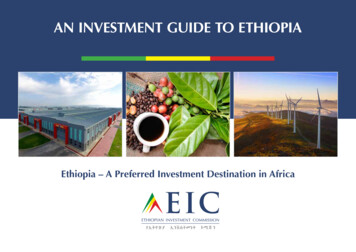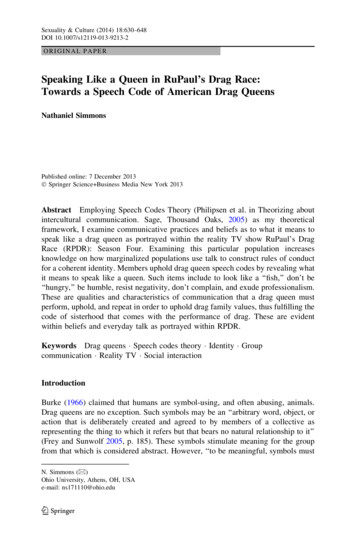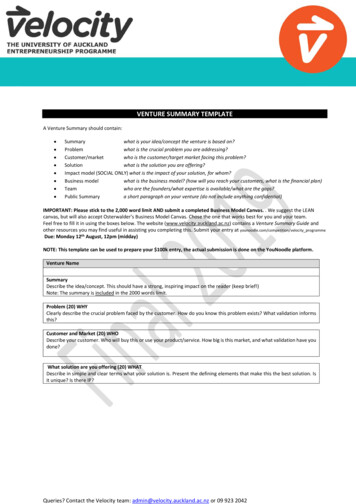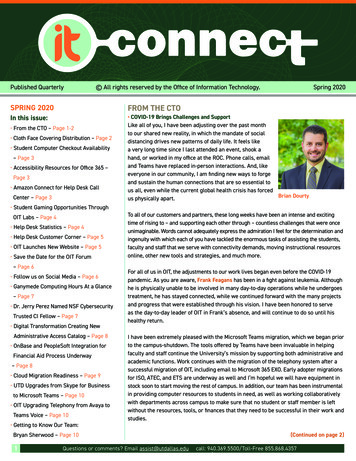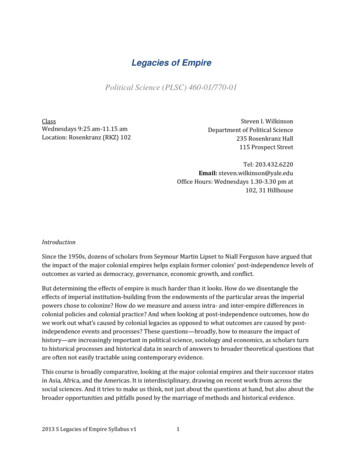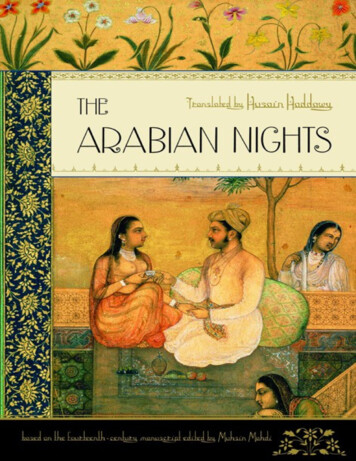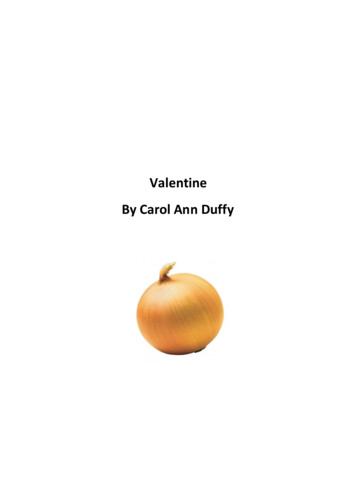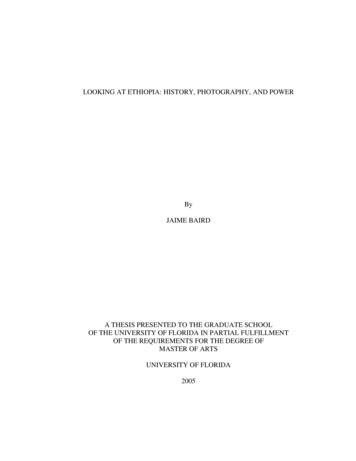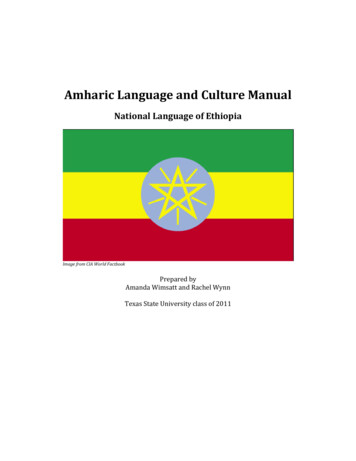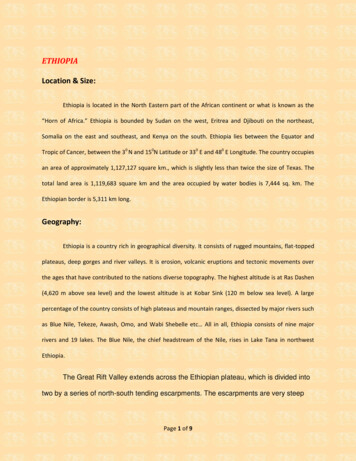
Transcription
ETHIOPIALocation & Size:Ethiopia is located in the North Eastern part of the African continent or what is known as the“Horn of Africa.” Ethiopia is bounded by Sudan on the west, Eritrea and Djibouti on the northeast,Somalia on the east and southeast, and Kenya on the south. Ethiopia lies between the Equator andTropic of Cancer, between the 30 N and 150N Latitude or 330 E and 480 E Longitude. The country occupiesan area of approximately 1,127,127 square km., which is slightly less than twice the size of Texas. Thetotal land area is 1,119,683 square km and the area occupied by water bodies is 7,444 sq. km. TheEthiopian border is 5,311 km long.Geography:Ethiopia is a country rich in geographical diversity. It consists of rugged mountains, flat-toppedplateaus, deep gorges and river valleys. It is erosion, volcanic eruptions and tectonic movements overthe ages that have contributed to the nations diverse topography. The highest altitude is at Ras Dashen(4,620 m above sea level) and the lowest altitude is at Kobar Sink (120 m below sea level). A largepercentage of the country consists of high plateaus and mountain ranges, dissected by major rivers suchas Blue Nile, Tekeze, Awash, Omo, and Wabi Shebelle etc All in all, Ethiopia consists of nine majorrivers and 19 lakes. The Blue Nile, the chief headstream of the Nile, rises in Lake Tana in northwestEthiopia.The Great Rift Valley extends across the Ethiopian plateau, which is divided intotwo by a series of north-south tending escarpments. The escarpments are very steepPage 1 of 9
towards the rift valley on either side. In general, the western high lands have high rimsin their western edges, but low lying plateaus and plains to the east and south.Climate:Ethiopia has four major seasons: Summer ‘Kiremet’ (June – August); Autumn‘Tibe’ (September – November); Winter ‘Bega’ (December – February) and Spring ‘Belg’(March – May). However, the coldest month is not always in ‘Bega’ and the hottestmonth is not always in ‘Kiremet’. Ethiopia lies near the equator where maximum heatfrom the sun is received. The length of days and nights are almost the same in mostregions. The average seasonal temperatures are:SummerLow of 100 CHigh of 390 CAutumnLow of 120 CHigh of 350 CWinterLow of 100 CHigh of 310 CSpringLow of 13.30 C High of 320 CThe rainfall decreases from the southwest to the northeast. The rainfall is largely concentratedduring the summer months of June, July and August.In general, the climate is moderate, except in the lowlands of the Danakil Desert and theOgaden, which are hot all the year. The highlands are temperate with night frost in the mountains. Asingle rainy season in the west brings twice as much rain as the wet seasons in the east.History:Page 2 of 9
Ethiopia is the oldest independent country in Sub Saharan Africa. The earliest evidence ofEthiopian history is around 1000 BC, when the queen of Sheba visited King Soloman. Ras Kassa hadhimself crowned as the emperor at Axum under a different name ‘Tewodros’. This happened in 1855when he constructed an army to reunite the provinces of Tigre, Amhara and Shoa. He later shot himselfin 1867 because the British blockaded his fortress. The ancient Ethiopian monarchy maintained itsfreedom from the colonial rule. One exception to this rule is the Italian occupation between 1936 and1941. In 1974 a military junta, the Derg and deposed Emperor Haile Selassie established a socialist state.Torn by bloody coups, uprisings, wide-scale drought and massive refugee problems, the regime wastoppled by a coalition of rebel forces, the Ethiopian Peoples Revolutionary Democratic Front (EPRDF), in1991. A constitution was adopted in 1994 and Ethiopia’s first multi-party elections were held in 1995. A2.5-year border war with Eritrea that ended with a peace treaty on December 12th 2000 hasstrengthened the coalition, but hurt the counties economy to a considerable extent.Calendar & Important Dates:Have you ever wondered why Ethiopian tourist promotion slogan reads “13 months ofSunshine?” well that’s because the Ethiopian calendar has 13 months a year, with 30 days each monthexcept the 13th known as ‘the Pagumen’ which means ‘additional’ in Greek. As of this year, 2002, theEthiopian calendar is eight years behind and indicates it is 1994. Ethiopia still retains the Julian calendar,named after Julius Caesar. The Ethiopian calendar is eight months behind the Gregorian calendar, whileEthiopian Easter coincides with Gregorian Easter once every four years.Ethiopian MonthMeskerem (New Year)Gregorian Calendar11 Sept – 10 OctPage 3 of 9
Tikimt11 Oct – 9 NovHidar10 Nov – 9 DecTahsas10 Dec – 8 JanTir9 Jan – 7 FebYekatit8 Feb - 9 MarMegabit10 Mar – 8 AprMiyazya9 Apr – 8 MayGinbot9 May – 7 JunSene8 Jun – 7 JulHamle8 Jul – 6 AugNehase7 Aug – 6 SeptPagume (5-6) days6 Sept – 10 SeptThe important days & public holidays in Ethiopia are:7 JanuaryEthiopian Christmas19 JanuaryEthiopian Epiphany (Timket)2 MarchVictory of Adwa Day6 AprilPatriots Victory Day12 April Ethiopian Good FridayPage 4 of 9
14 April Ethiopian Easter1 MayInternational Labor Day28 May Downfall of the Dergue11 September Ethiopian New Year27 September MeskalPopulation & People:The total population of Ethiopia is approximately 65,891,874 people according to a 1998 census.The age structure is 47% under 14 years, 50.03% between 15 years and 64 years, 2.79% over 65 years.The population growth rate is 2.7% (2001 estimate), the birth rate is 44.68 births per 1,000 people (2001estimate), death rate is 17.84 deaths per 1,000 people (2001 estimate) and the migration rate is 0.13migrants per 1,000 people (2001 estimate). The life expectancy at birth for the total population is 44.68years while for males it is 43.88 years and females is 45.51 years.There are 76 nationalities in Ethiopia. The break up for the ethnic groups are: Oromo 40%,Amhara & Tigre 32%, Sidamo 9%, Shankella 6%, Somali 6%, Afar 4%, Gurage 2% and others 1%.Currency:The official currency of Ethiopia is the Ethiopian Birr (Birr 100 Cents). The notes are indenominations of Birr 100, 50, 10 and 5. Coins are in denominations of 50, 25, 10 and 5 cents. ThePage 5 of 9
import of local currency is limited to Birr 100 and the export of local currency up to Birr 100 ispermitted provided the traveler holds a re-entry permit. The import and export of foreign currencyis unlimited, subject to declaration on arrival. As of March 13, 2002:U.S. 1 8.36 Ethiopian Birror1 Ethiopian Birr U.S. 0.12Education:The definition of literacy in this context is ages 15 and over can read and write. The literacy ofthe total population is 35.5%. Male literacy being 45.5%, and female literacy being 25.3%. The primaryeducation consists of six years and the primary enrollment ratio is 43%. The male youth illiteracy is 47%.On an average, there are 43 students per teacher in a class.Education in Ethiopia was oriented towards religious learning until after World War II, when thegovernment began to emphasize secular learning as a means to achieve social mobility and nationaldevelopment. The education system today suffers from inadequate financing. Education was severelydisrupted during the civil war. Secondary education is in English and Amharic. Addis Ababa Universityhas been a center of political activity, usually anti-EPRDF, and is subjected to periodic closure and thesacking of leading academics. The Addis Ababa University has an enrollment of around 15,347 people.Language:Although Amharic is considered the official language of Ethiopia, there are anastonishing 83 languages spoken in the country with 200 dialects. However the majorlanguages are Amheric, Tigrinya, Oromigna, Guaragigna, Somali, Arabic, EnglishPage 6 of 9
(major foreign language taught in school). Amheric is spoken by approximately 31% ofthe countries population.Religion:Ethiopia is a platform for many different religions, beliefs and practices from time in memorial.The major religion in Ethiopia is Christianity. The other major religions present in Ethiopia are Islam andJudaism. These persuasions exist together and contemporaneously without causing any noticeableshock in the social, cultural and political life of the country. The break of the religions are as follows:Muslim 45% Ethiopian Orthodox 40%, Animist 12%, Others 3% - 8%.Agriculture:Agriculture accounts to over 40% of the GDP, 80% of the exports and 80% of the labor force.Agriculture remained in 1991 the economy’s most important sector. Ethiopia has great agriculturalpotential because of its vast area of fertile land, diverse climate, generally adequate rainfall and largelabor pool. Despite its advantages, Ethiopian agriculture remains underdeveloped and outdated. Amajor cause for the underdevelopment is the drought, which persistently affected the country since theearly 1970’s. The country also has a poor economic base (low productivity, weak infrastructure, and lowlevel of technology). According to the World Bank, between 1980 and 1987, agricultural productiondropped at an annual rate of 2.1 percent, while the population grew at an annual rate of 2.4 percent.Consequently, the country faced a tragic famine that resulted in the death of nearly one million peoplefrom 1984 to 1986.Land use in Ethiopia consists of 12% arable land, 1% permanent crops, 40% permanent pastures,25% forests and woodlands and 22 % others according to a 1993 census. The fertilizer consumption was159 grams per ha of arable land (1998). The major cash crops are coffee and tea and the major foodPage 7 of 9
crops are maize, wheat, barley, sorghum, millet, teff and potat. In 1999, the agricultural GDP was 52%.The cereal yield was 1,141 Kgs. In 2000.Economy& Trade:On the scorecard, Ethiopia’s world GNP ranking is 99 and the GNP per capita is 110. Ethiopiahas an inflation rate of approximately 3.7%. Since the end of the civil war, Ethiopia is one of the world’spoorest counties. Ethiopia has begun moving toward a market economy by encouraging foreigninvestment and reforming land tenure. Economic decline was reversed in 1993 as the agricultural andindustrial output grew. The latter was fueled by the purchase of parts and raw materials funded byforeign aid.The major export items are coffee, animal skins and hides, chat, flowers, pulses, and vegetables.Most of Ethiopia’s exports are to Germany, USA, Japan, Italy and France and most of their imports comefrom UK, Germany, Japan, USA and Italy. In 1998, the GDP was 32.9 billion, export 550 million andimport 1.3 billion.The major weakness of the Ethiopian economy is the dependence on agriculture, periodicserious droughts, and a war-damaged infrastructure.Food:Ethiopian food is like the Ethiopians themselves: spicy, subtle, piquant and most of allunforgettable. A formal Ethiopian meal begins with the washing of hands. An Ethiopian meal might leadyou to think you were already in heaven. Beef cooked, raw, cubed, ground and marinated in a fiery redpepper sauce with more flavors blended in than the most sophisticated foreign palate can identify.However ‘Doro Wot’ (Chicken in sauce) is probably the most widely known Ethiopian dish of all. A festivemeal without a richly flavored doro wot, hard-boiled eggs is practically a contradiction in terms. MostPage 8 of 9
Ethiopian food is served over ‘Injera’ (slightly sour pancake). Other popular Ethiopian dishes are ShiroWet, Enset Kitta, Kitfo and so on Landmarks:The Menelik Mausoleum: Built in 1911 in the old Baata church it serves as a tomb for emperors,princess and martyrs of freedom.St. Geroge’s Cathedral: Built in 1896 in the traditional octagonal shape by emperor Menelik II tocommemorate his victory at Adwa.The National Museum: Houses numerous antiquarian relics and archaeological artifacts.Trinity Cathedral: Built in 1941 to a European design in commemoration of Ethiopia’s liberationfrom Italian Occupation.Jubilee Palace: It is a modern palace to commemorate the silver jubilee of the coronation ofEmperor Haile Selassie I.Alagappan AnnamalaiPage 9 of 9
Ethiopia is located in the North Eastern part of the African continent or what is known as the . single rainy season in the west brings twice as much rain as the wet seasons in the east. . death rate is 17.84 deaths per 1,000 people (2001 estimate) and the migration rate is 0.13 migrants
